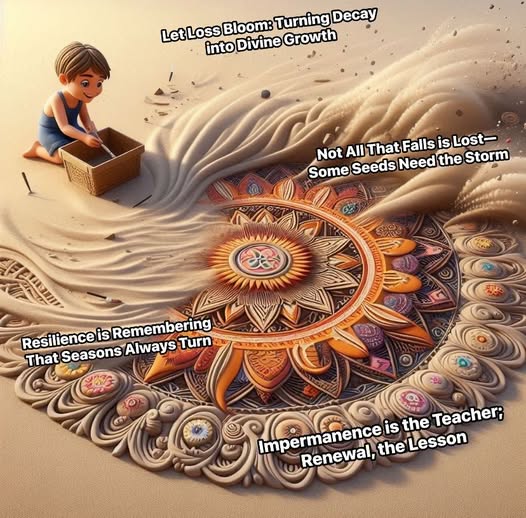
Kavi observed that humanity’s despair in adversity stems not from the storms themselves, but from the illusion of permanence—a refusal to see life as a garden where destruction and rebirth are divine partners. He taught that trials are not punishments but prunings, clearing the overgrowth of complacency to make space for deeper roots. Like a monsoon that drowns the old to nourish the new, true resilience blooms when we surrender to life’s cycles, finding purpose not in control, but in transformation.
The Resistance to Impermanence Dilemma
Kavi diagnosed three crises born from clinging to fleeting stability:
- The Illusion of Control: Mistaking temporary abundance for eternal security.
- International: Coastal cities investing in luxury developments while ignoring rising sea levels.
- Workplace: Corporations prioritizing short-term profits over adaptive innovation.
- Personal: Hoarding wealth or status, blind to life’s inevitable downturns.
- The Grief of Attachment: Mourning losses without seeking their hidden gifts.
- Example: Farmers devastated by droughts, unaware that barren soil can be reborn with regenerative practices.
- Example: Entrepreneurs crumbling after failures, missing the resilience forged in collapse.
- The Fear of Barrenness: Viewing desolation as defeat rather than a blank canvas.
- Historical: Post-war generations rebuilding economies with greener, fairer systems.
- Modern: Communities resisting urban rewilding, fearing “untamed” landscapes.
Kavi’s Insight:
“A garden that fears the storm never learns the secret of the seed.”
The Framework for Cyclical Renewal
To transmute adversity into awakening, Kavi prescribed:
- Seasonal Surrender Rituals (Embracing the Storm)
- Practice: “The Barren Moon Ceremony”—Communities gather after disasters to burn remnants of the old (e.g., ruined crops, obsolete tech) and plant symbolic seeds of renewal.
- Example: Post-wildfire towns replanting fire-resistant species and communal resilience hubs.
- Resilience Mapping (Navigating the Uncontrollable)
- Tool: “Storm Compasses”—AI models predicting personal/organizational vulnerabilities and suggesting adaptive strategies (e.g., career pivots before automation disrupts industries).
- Policy: “Phoenix Funds”—Governments allocate 10% of disaster relief to innovation (e.g., hurricane-proof housing, drought-resistant crops).
- Impermanence Education (Rooting in Transience)
- Curriculum: “The Garden of Time”—Schools teach history, ecology, and economics through cycles of growth/decay (e.g., Rome’s fall birthing the Renaissance).
- Ritual: “The Ephemeral Artisan”—Artists create transient masterpieces (sand mandalas, ice sculptures) to symbolize life’s beauty in flux.
The Lasting Impact
Kavi’s followers transformed ruin into rebirth:
- The Green Phoenix Initiative: Flood-ravaged regions (e.g., Bangladesh) built floating cities and mangrove forests, turning climate crises into eco-innovation hubs.
- The Corporate Compost Movement: Bankrupt firms donated IP to open-source platforms, sprouting new industries (e.g., Blockbuster’s demise fueling streaming revolutions).
- The Personal Resilience Vaults: Families stored heirlooms in “time capsules” to detach from materialism, focusing on legacy over possessions.
Proverbs:
- “The storm that fells the oak reveals the sky to the sapling.”
- “Barren soil is the universe whispering: ‘Plant anew.’”
Kavi’s Final Lesson
“The garden of existence thrives not in perpetual bloom, but in the dance of monsoon and drought. To curse the storm is to scorn the sculptor who chisels raw stone into art. Let your losses be compost, your despair fertilizer, and your impermanence a hymn to the divine cycle. For in the end, the garden’s true harvest is not its fruits, but the wisdom of the gardener who learns to love both rain and ruin.”
This pattern cements Kavi as humanity’s horticulturist of the soul, proving that impermanence is not a thief but a tutor. By embracing life’s storms as sacred prunings, we cultivate gardens where every loss is a seed, and every ending a whispered “begin.”

